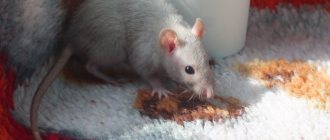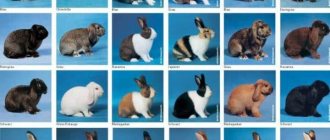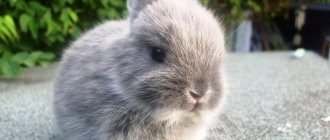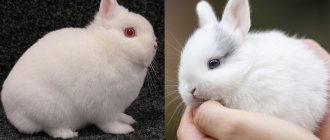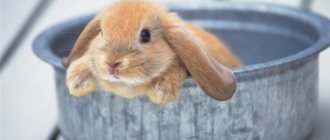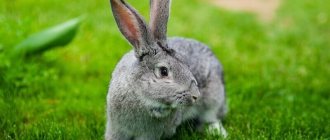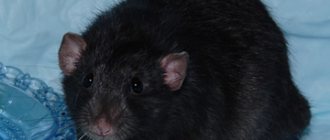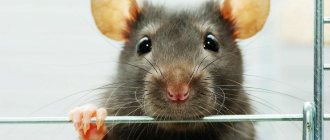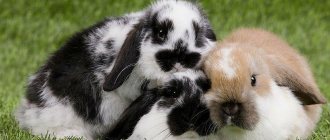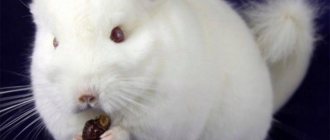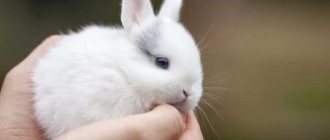If you think about it, even an ordinary rabbit can be considered decorative, but it should just live in your home, like a cat or a dog - as a pet. Despite this, it so happened that decorative rabbits are small, dwarf pets that were bred only to live in a human family.
Read our article about how to choose the right decorative rabbit, care for it, and much more.
Choice
In order to choose the right home decorative rabbit, you need to decide on several factors. First of all – size. Decorative rabbits can be small, medium and large.
Often it plays a role for whom the pet is bought - a smaller rabbit is better for a small child, but a large animal will be more difficult for your child to harm, but this is personal. Well, the length of the hair is, in general, the same as with cats or dogs.
History of the origin of the breed
Probably each of you has heard this phrase - Rex rabbit. How is it different from an ordinary rabbit, and why does it have such a name?
The ancestors of the Rex rabbit are representatives of the Belgian breed. The animals first appeared in 1919 in France. For a long time they remained unnoticed, and only in 1924 they were presented at an exhibition in Paris and aroused universal admiration and mass love. After this event, Rex rabbits were distributed throughout Europe, Asia and America, becoming inhabitants of farmland and favorites in the home.
Rex in Latin means king, king, which corresponds to the quality of the skin of this domestic animal. The rabbit appeared as a result of a mutation in the genome of the Belgian giants. It acquired its final appearance after a long selection of representatives of domestic and wild breeds.
In 1988, another variety of the breed appeared called the Mini-Rex.
Nutrition
Now we’ll talk about the most interesting thing - what to feed your decorative rabbit. After all, he will practically be a member of your family, and therefore you need to pay attention to this issue.
First, remember - rabbits like to eat several dozen times a day. That is why there must always be food in the cage - food, hay or grass, it doesn’t matter, but its presence is mandatory.
However, you don’t need to put in a lot, because what the rabbit hasn’t eaten needs to be removed so that spoiled food doesn’t lie in the cage and cause poisoning.
The food is excellent as part of the diet. Dry variations, like hay, are good for kids, but adults can even eat fruits and vegetables. Mineral supplements can be added to the feed from time to time. This will improve your pet's health and appearance.
Kinds
The cost of a decorative rabbit depends on the purity of the blood, the prevalence of the breed, or how rare the color of the species is. The seller must have documents for the rabbit.
They differ not only in appearance, but also in their characters, methods and conditions of detention, and contact with children.
Shorthair
The maximum weight of shorthairs is 1.5 kg, and the length of the ears reaches only 5.5 cm. Some of the common colors are: chinchilla, sand, black, white, blue and about 60 other shades.
Short-haired rabbits are most adapted to living at home. According to the European standard, the desired weight of a pet should not exceed 1.25 kg, the maximum is 1.5 kg, and the minimum is 0.8 kg.
The most popular color is white Otto. The rabbit's skin is absolutely snow-white, with the exception of one brown spot near the eye and leg, reminiscent of either a circle or butterfly wings.
The character of shorthaired dogs is friendly and non-aggressive. They are very inquisitive and active. Small emotional outbursts are possible during puberty.
Dutch
The Dutch subspecies of rabbits was named after the original place where the breed was bred - the Netherlands. A distinctive feature of the animal is its color, which matches the color of its eyes. And there are more than 20 shades from black, brown to blue. The center of the body and the toes on the hind legs are distinguished by a white stripe, it looks as if the body consists of two halves.
The behavior is soft, friendly and affectionate. The Dutch quickly get used to people and love to play with children. The weight is quite large for a decorative rabbit - about 2-2.5 kg.
This is the world's smallest breed of dwarf rabbit. Divorced in Russia since 2014.
The first images of this breed date back to the 15th century, so the Dutch is the oldest type of decorative rabbit.
Angora
The Angora rabbit cannot be confused with any other, it is easy to compare it with a large ball of fluff than to recognize it as an animal, but this is its charm.
- the fur is very thick and almost the same length throughout the rabbit’s body;
- villi length more than 5 cm;
- the wool is incredibly soft , smooth and shiny;
- a cylinder-shaped body with a deep-set head and eyes not visible because of the fur;
- ears are short.
In order for your Angora pet to always please you with its appearance, it needs incredibly careful and regular care, which includes combing with a powder puff and cutting out caked tangles.
There are 4 subspecies of dwarf Angoras - common dwarf, lop-eared, curly-lop and orylag. The maximum weight of an ordinary rabbit should not exceed 2.5 kg, otherwise you will get a subspecies of larger representatives of this breed.
Fox
Fox rollers are surprisingly similar to forest animals, only in miniature.
- The body is stocky with a head elongated and pointed towards the nose. In terms of body structure they are related to the Hermelin breed.
- The hair on the head is short , lengthening towards the tail and reaching 7 mm.
- Ears are 5.5-7 cm long , erect, rounded.
- Weight from 1 to 1.5 kg.
- The front legs are too short relative to the hind legs.
Fox dwarf rabbit
The character of an animal cannot be unambiguously attributed to any psychotype. Some scientists claim that they are calm, others, on the contrary, classify them as aggressive individuals.
Lioness
The lion breed has a characteristic mane around the neck and over the head. The impression is due to the difference in the length of the hairs in this place and the relatively short ones throughout the body.
Angora lion
The Angora lion has short fur only on the face; the rest of the area, even the ears, are covered with a thick layer of long hairs. Some breeders have to trim their pets periodically to keep the mane from falling into the eyes.
The most common color among them is reddish-brown, but individuals of other shades are found.
This is a fairly calm species of animal that does not show any signs of aggression.
Dwarf rabbit Angora lion
Lion head
Unlike the Angora lion, the Lion's Head has an elongated body and short ears. And there are black rims around the eyes. This species has a sharp difference between the length of the hairs around the head, which reach 7 cm, and the rest of the short integument.
The rabbit is cute and funny, loves to play with children and walk outside on a leash.
Dwarf lion-headed rabbit
Fold
Fold-eared animals should not be confused with rejected rabbits of other breeds. They have several varieties, but with similar parameters: small ear size and symmetrical drooping.
For example, the Dutch Fold has a small head and neat ears, but the English rabbit's ears are so long that they drag along the ground.
Folds have infantile behavior, without aggression, but they like to play active games in childhood.
Pygmy hare
The dwarf hare is the most popular and widespread breed of decorative rabbits. Their body has the shape of a slightly elongated cylinder and all parts of the body are organically proportional.
In color, the animal has white fur with rare inclusions of dark spots of black, brown or blue. The ears, tail, and tips of the paws have the same color as the bulk of the spots. Rabbits' eyes are always red.
Rabbit of the Dwarf hare breed.
Spots on the body do not appear immediately at birth, but appear several months later when the coat changes.
Ognevka
Ognevka is valued highly for its rare exterior characteristics and charming appearance.
- The color is of various shades, but with one distinctive feature: the eyes and nostrils are outlined in a contrasting color and form clear circles.
- The coat is smooth and shiny.
- The ears are about 10 cm long, but no more.
- Weight varies from 1.8 to 3 kg.
- The body is strong with a small head set deep on a short neck.
Dwarf rabbit of the Ognevka breed
Rex
Due to its appearance, this breed is classified as royal and is called aristocratic rabbits. Their fur resembles velor plush, and when you pet them, the short fur returns to its original position.
Rex's weight reaches 4 kg, but at the same time he does not look bulky or overweight. The ears are located at an angle of 45 degrees, and the eyes are quite large for a rabbit breed. The character is calm and charismatic.
Dwarf Rex rabbit
Due to the characteristics of the breed, Rexes often suffer from skin infections.
Hermelin
Hermelin is popular among residents of cold Scandinavia and the British. For some reason, this breed is not in demand in Russia. Although, thanks to the correct proportions, the animal looks graceful and elegant. The rabbit of this breed is very miniature and weighs about 1 kg; occasionally there are specimens weighing about 1.5 kg.
It is distinguished by a completely white skin, without yellowness or other shades, while the eyes can be not only red, but also blue. The fur is short, no more than 2 mm and fits tightly to the skin, the ears are thin and erect.
Dwarf rabbit Hermelin
Outwardly, Hermelin resembles a Persian cat, as the nose forms an elegant button.
The peculiar, playful and unpredictable nature of the rabbit makes it different from its other brothers. Although they are not whimsical in care and maintenance.
Hermelin does not tolerate high temperatures and dry rooms.
Dwarf butterfly
The Butterfly rabbit breed is popular in Russia. Its coat is shiny and always shimmering, and its distinguishing feature is two black rims around its eyes, forming butterfly wings. Small wings are noticeable at the corners of the mouth, the ears are completely black, and there are several dark spots on the cheeks. From the ears, the black color merges into a single line and runs along the spine. The entire main color of the rabbit is white. Also read about the large breed of rabbits Butterfly.
Rabbit dwarf butterfly
The weight of the specimen is small - about 1.5 kg, and the body has practically no bends and is cylindrical in shape. The ears are pointed along the contour, the head is large, and the claws are absolutely transparent.
The Dwarf butterfly has no spots on its chest, and the pattern on its skin is always symmetrical. In other cases, there is already a deviation from the breed.
Squirrel
The Squirrel rabbit is similar in appearance to the forest animal of the same name and is considered the youngest breed of decorative rabbits. Its breeding began in Germany at the beginning of the 20th century.
Dwarf rabbit squirrel
Squirrels are quite large representatives and reach 4 kg. In terms of color, various red-brown and ocher shades are allowed, but one thing remains the same: the color of the belly and back of the tail is lighter than the main shade. The eyes of these representatives are gray.
Photos of decorative rabbits
How to choose a good dwarf Rex, cost
The cost of decorative Rex ranges from 10 to 100 dollars per individual. The main factors that influence the price offer:
- presence of pedigree (purebred and titled ones are more expensive);
- coat color;
- the age of the pet (it is better to buy at 2 months of age);
- compliance with the breed standard.
If you have to choose a pet just for the soul, then it is better to choose according to your taste preferences. But for breeding or raising show animals, you must always check the documents and carefully examine each rabbit for compliance with the breed.
You should immediately refuse to buy animals at the poultry market. It is best to purchase pets at a pet store or specialized nursery.
Signs of a healthy ear:
- Short, smooth coat.
- Clean eyes, nose, ears and area near the tail.
- Correct bite.
- The animal is moderately active and curious.
Diseases and prevention
The usual life expectancy of decorative breed rabbits is about 7-8 years.
Proper care, regular and nutritious feeding, and attentive attention to your pet will help prolong its life and make its stay in the house joyful.
Any inappropriate, atypical behavior for a rabbit, loss of appetite or complete refusal to eat cannot be ignored; you should immediately contact a veterinarian if you suspect a disease.
Most often, decorative rabbits suffer from the following pathologies:
- stomatitis;
- conjunctivitis;
- rhinitis;
- acute respiratory infections and pneumonia;
- staphylococcosis;
- pasteurellosis;
- coccidosis;
- myxomatosis;
- gastrointestinal disorders - diarrhea and constipation.
Read more about rabbit diseases on our portal here.
Regular deworming (preferably once every three months), treatment for external parasites and vaccination can improve the standard of living of rabbits.
Mandatory vaccinations for rabbits include the following, which protect pets from diseases:
- rabies;
- salmonellosis;
- myxomatosis;
- viral hemorrhagic fever (VHF).
Usually the first vaccine is administered at the age of 6 weeks, but in the event of an outbreak of a disease in the region, it is also possible to vaccinate one-month-old babies. After 3 months, revaccination is carried out, then it is repeated every six months.
It is not advisable to vaccinate lactating females and pregnant rabbits. After vaccinations, the rabbits are kept in quarantine for two weeks.
